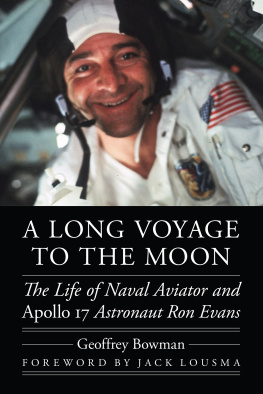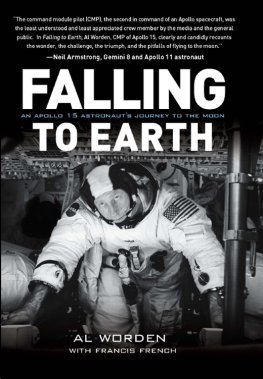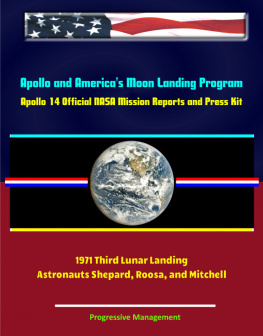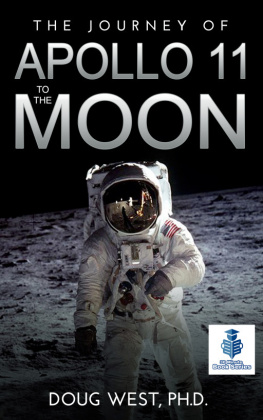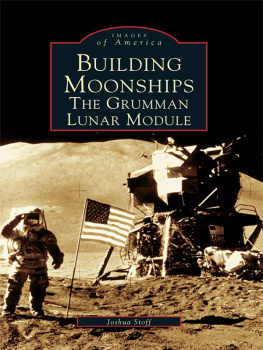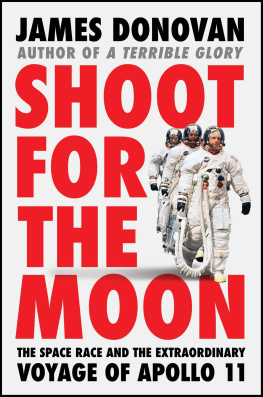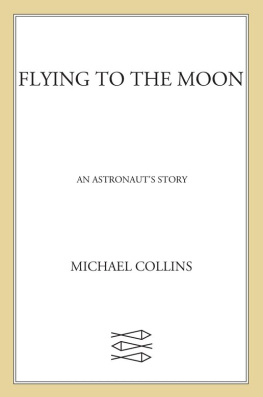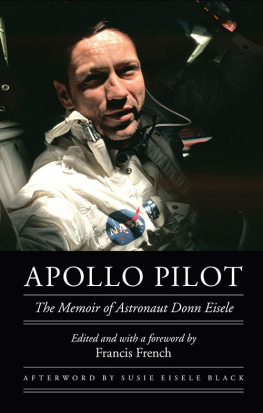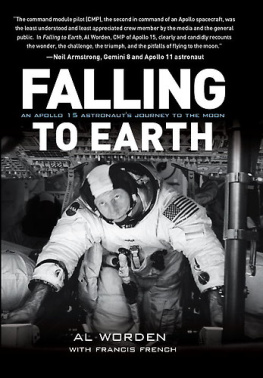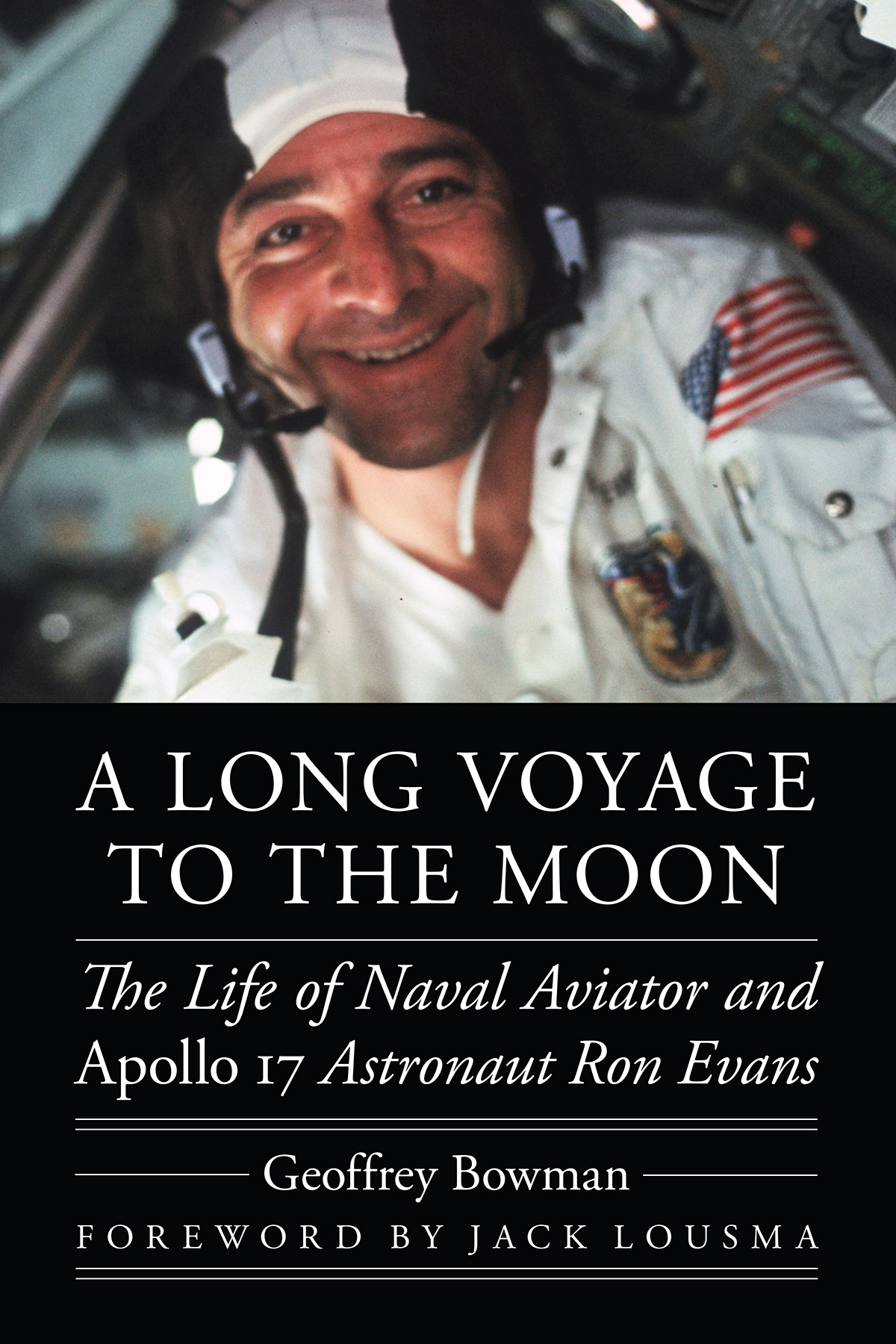
From a small town in Kansas to dodging enemy rockets in a jet fighter over North Vietnam to orbiting the moon on Apollos final lunar voyage, here is the extraordinary journey of Ron Evans. In this thoroughly detailed biography, Geoffrey Bowman captures a man of unflappable calm and easygoing warmth who met the final frontier with unabashed exuberance. In these pages, youll learn why Evans left countless people, myself included, feeling honored and glad to have known him.
Andrew Chaikin, author of A Man on the Moon: The Voyages of the Apollo Astronauts
Ron Evans is one of the unsung heroes of the Apollo program.... I am delighted that this book now tells the story of Rons remarkable life.
Farouk El-Baz, geologist and trainer of Apollo astronauts in observation and photography
Ron Evans and I were selected as NASA astronauts in 1966. I enjoyed my time with Ron during our rookie years through a variety of training before I was selected for Apollo 13 and Ron for Apollo 17. This very interesting and informative account of Rons life and career emphasizes how we shared with many others the immense privilege of having been a part of the Apollo program.
Fred Haise, lunar module pilot on Apollo 13
Outward Odyssey
A Peoples History of Spaceflight
Series editor
Colin Burgess
A Long Voyage to the Moon
The Life of Naval Aviator and Apollo 17 Astronaut Ron Evans
Geoffrey Bowman
Foreword by Jack Lousma
University of Nebraska Press | lincoln
2021 by the Board of Regents of the University of Nebraska
Cover designed by University of Nebraska Press; cover image courtesy of NASA .
All rights reserved
Library of Congress Cataloging-in-Publication Data
Names: Bowman, Geoffrey (Geoffrey Alexander), author. | Lousma, Jack, 1936 writer of foreword.
Title: A long voyage to the moon: the life of naval aviator and Apollo 17 astronaut Ron Evans / Geoffrey Bowman; foreword by Jack Lousma.
Description: Lincoln: University of Nebraska Press, [2021] | Series: Outward odyssey: a peoples history of spaceflight | Includes bibliographical references and index.
Identifiers: LCCN 2020051336
ISBN 9781496213198 (hardback)
ISBN 9781496228260 (epub)
ISBN 9781496228277 (pdf)
Subjects: LCSH : Evans, Ronald E., 19331990. | AstronautsUnited StatesBiography. | Project Apollo (U.S.)
Classification: LCC TL 789.85. E 93 B 69 2021 | DDC 629.450092 [B]dc23
LC record available at https://lccn.loc.gov/2020051336
The publisher does not have any control over and does not assume any responsibility for author or third-party websites or their content.
For Jan
This is your story, too.
What is it, I wondered, that makes a man willing to sit up on top of an enormous Roman candle, such as a Redstone, Atlas, Titan or Saturn rocket, and wait for someone to light the fuse?
Tom Wolfe, The Right Stuff
Contents
Ron Evans was a very special individual. Knowing him as I did during those golden years for space exploration, it was not merely a classic case of right place, right time for him, as he was a man endowed with a tremendous combination of qualities and skills that came together to set him on a steady course to the moonone of only twenty-four human beings to do so. His career certainly paralleled mine in many ways, and as I reflect on his life and accomplishments for this book, I can easily recall his openness and sincerity, his determination to do the best he could, and his pride in overcoming whatever challenges he faced, be it as a U.S. Navy combat pilot or a NASA astronaut. Through all of our shared years, I also knew him as a devoted husband and father to his beloved wife, Jan, and their children, Jaime and Jon.
In past interviews, I have pointed out that when I was youngand this would apply equally to Ronthere were no such things as astronauts. In fact, that word did not even exist. We grew up in an era of magical childish imagination, fueled by unmissable Saturday movie serials, comic books, and cartoon characters like Alley Oop, the time-traveling caveman, with his dinosaur companion. We also had fictional space heroes like Buck Rogers and Flash Gordon bringing us the wondersand terrorsof space travel. Never in our wildest dreams could we have imagined that one day we, too, would be riding rockets into space. It still feels somewhat surreal that we did those things.
Ron Evans and I were selected in NASA s Group 5 astronaut contingent in April 1966, but our lives were running somewhat parallel before then. In 1963, having served as a jet attack pilot at the U.S. Marine Corps Air Station Cherry Point, North Carolina, and overseas at Iwakuni, Japan, I began two years of study at the U.S. Naval Postgraduate School in Monterey, California, where I had undertaken the aeronautical engineering course. There I met or at least knew of several top-notch pilots who would one day join NASA s astronaut corps, including Gene Cernan, Dick Gordon, Paul Weitz, and Ron Evans. I was a full year behind Ron, and I would later learn that he had already applied to NASA for selection as a Group 3 astronaut, albeit unsuccessfully. The master of science degree he achieved at the postgraduate school, also in aeronautical engineering, surely added an additional, vital qualification that helped him to succeed the next time he applied.
Military officers at Monterey were still on active duty during the postgraduate schools summer (no class) period and had to do something military-career productive. I now know that Ron took a short summer course in the Russian language at the Monterey-based Defense Language Institute. Some years later, when I feared that the Skylab Program might be canceled, I took a University of Maryland off-campus study course in the Russian language, on my own time, in case the rumored mission with the Soviets might be my only option for a space flight. Neither Ron nor I could have known that a few years later we would actually be training together and speaking Russian with our onetime Cold War enemies for the Apollo-Soyuz Test Project.
It was an exciting time when we were both attending the Naval Postgraduate School. The United States and the Soviet Union were then engaged in a monumental undertaking that had come to be known as the space race to the moon. Already the first astronauts and cosmonauts had begun flying ever longer and increasingly adventurous missions in Earth orbit. How we admired them! Despite this, I had not yet acquired the credentials even to apply to become an astronaut in our nations space program. Of course, Ron had, and as it turned out, we ended up at NASA together!
After graduating from the postgraduate school, I was assigned to a U.S. Marine Corps Photo Reconnaissance Squadron at Cherry Point. Ron and I both flew the Vought F -8 Crusader but at different times and places. We loved flying that powerful supersonic jet aircraft. It was a single-seater, so you didnt have to fly with anybody else. It had an afterburner, and you could fly high and fast or low and fast. I was flying photo recon in the F -8, again with the Second Marine Air Wing based at Cherry Point. I was also trained to operate off aircraft carriers and made about eighty carrier landings in various airplanes, while Ron was assigned to sea duty aboard the USS Ticonderoga ( CV -14), flying the F -8 in combat operations over Southeast Asia. During two combat cruises, he completed more than a hundred missions. In the meantime, we had both learned that NASA was seeking a new group of astronauts, and we applied.
Next page
